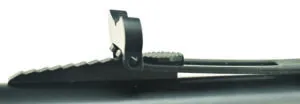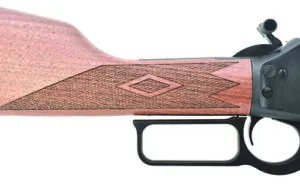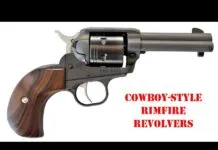GUN TESTS GRADE: A (BEST BUY AND OUR PICK)
$633
The 1894 Winchester is the type of firearms success story every manufacturer wishes they could duplicate. Trim, thin and capable of housing a powerful cartridge, more than six million ’94s have been sold over the 120+ intervening years. Standard production ceased for those rifles in 2006. Excellent copies are now being made by Miroku in Japan and imported by Winchester. They are certainly still available, albeit at a premium price.
| Action Type | Lever, side ejection, solid-top receiver |
| Overall Length | 37.0 in. |
| Barrel Length/Twist | 18.5 in., 1:20, Ballard-type rifling, 6 grooves |
| Overall Height w/o Scope Mount | 8.0 in. |
| Weight Unloaded | 6.75 lbs. |
| Weight Loaded | 7.2 lbs. |
| Sight Radius | 14.2 in. |
| Action Finish | Matte blue |
| Barrel Finish | Matte blue |
| Magazine Capacity | 4 |
| Magazine Type | Tube |
| Stock | Black walnut, Mar-Shield finish; straight grip, cut checkering |
| Drop at Comb | 1.2 in. |
| Drop at Heel | 1.9 in. |
| Bedding | None |
| Buttplate | Ventilated recoil pad |
| Length of Pull | 13.4 in. |
| Front Sight | Ramp with brass bead and Wide-Scan hood |
| Rear Sight | Adjustable semi-buckhorn folding |
| Receiver Scope-Base Pattern | Weaver 63B |
| Trigger Pull Weight | 5.7 lbs. |
| Safety | Hammer block |
| Warranty | 5 years |
| Telephone | (800) 544-8892 |
| Website | MarlinFirearms.com |
| Made In | U.S.A. |
The Marlin 1895 lever action was introduced a year later and has also sold extremely well. The style is the same, though, any number of details are different such as the width of the receiver, where the lever hinges, etc. In our opinion, perhaps the most important difference comes in the design of the two receivers. Continuing with the tradition from earlier models, such as the 1866 and the 1873, the Winchester ’94 has an open-top receiver. That makes the working parts in the action very accessible. It also makes it very difficult to properly mount a scope. That was a moot point in 1894, but something that is increasingly necessary today. The Marlin 1895, as mentioned, has a solid bridge on the top of the receiver, and current models come already drilled and tapped for optics. Whether your planned use for the rifle is in-the-deep-woods close or something a bit farther out, mounting the glass is easy.

Our sample is called the Guide Gun, and we think it is designed well for the intended purpose. The 18.5-inch barrel is fairly stout, measuring 0.77 inch at the muzzle. The crown is well recessed in case you bang it into a willow as you walk slowly through the thicket praying you don’t run into that bear. The sights are traditional lever-action style all the way. The front sight is a ramp covered by a hood. The sight blade proper shows a shiny piece of bright metal to the shooter for aiming purposes. It does not look like a brass bead. It may just be a bit of paint and it might have been faced off with a file. Still, it is considerably more visible than flat black. The rear sight is a buckhorn style with a shallow notch. It uses the customary elevator bar to raise the rear sight, which is mounted in a dovetail so it is drift adjustable for windage. The four-round magazine tube is well protected by the forend and has an additional bracing contact with the barrel in the way of a dovetail at the end of the tube.

The action has two openings on the right side. The first is the ejection port, and the fairly massive bolt is visible in the port window. When the lever is rotated to the front, the bolt moves to the rear, exposing a large notch into which the locking bolt extends. This is a strongly made design, ready for some serious loads. As noted, the hinge point on the lever is actually under the receiver instead of inside, as on the Winchester. This changes how flat the bottom of the action is and forces the hand a little farther forward when the shooter goes to carry the rifle one-handed. Even so, balance is good, and it carries comfortably. The action was a bit rough when first received, but many lever actions are and it smoothed up quickly. One modification we might consider is the large-loop lever as available from Brownells (550-000-698WB, $80).

With some of our testers having big hands, the heavier loads were coming back and “tapping” our knuckle almost every shot. That got a little old, but that was much more a factor of the ammo than the rifle. As on the Henry, the magazine came complete with an orange follower, helping us quickly see if we were about to be out of ammo. The hammer spur comes with a cocking extension attached to help you manipulate the hammer with a scope attached. The trigger was a bit heavy at 5+ pounds, but it was clean and consistent to use. The Marlin uses an unobtrusive hammer-block safety, mounted just below the hammer and easily accessed. We give props to Marlin for the instruction manual, which shows step-by-step instructions on how to detail strip and reassemble the rifle.

The stock is a two-piece set of black walnut with a Mar-Shield finish and showed some nice grain. Wood-to-metal fit was tight, and everything ended with a proper recoil pad. The checkering surprised us a bit. The design, angles and the diamond patterns, were all sharp and well cut. The checkering proper had enough texture to help us mount the rifle in our shoulder and run it from there with little movement. But the checkering itself needs some work. Too many of the lines appeared to have been cross-checkered. That, however, was about the only thing we found an issue with on the appearance of this rifle. You also get two sling-swivel studs mounted fore and aft.
We shot two groups on these rifles with open sights. Flat-black iron sights and what we are going to call “experienced” eyes aren’t always the best match — this rifle was no different. The groups for the Marlin measured about 4.5 inches at 100 yards, about the proverbial minute of deer. Then we mounted the Sightmark scope, and things changed for the better. Frankly, we were astounded. The rifle ate everything we fed it, and the cumulative average for all groups fired with factory ammo was 1.25 inches. Its best group was a mere 0.58 inches, and we hit the sub-inch goal a number of times.
Our Team Said: We think this rifle would be an excellent choice for an all-around rifle out to several hundred yards if it were mated with a good 1-4x or 1-6×24 scope with “tick marks” on the reticle to aid in instant range adjustment.
45-70 GOVERNMENT RANGE DATA
All groups were shot at 100 yards from a solid bench using a Caldwell TackDriver front rest ($44 at MidwayUSA.com) and a T.A.B. Gear large rear bag ($30 at TABGear.com) with the heavy fill. Muzzle velocity was determined using a LabRadar chronograph ($559 at BuyMyLabradar.com). Location: American Shooter Centers (AMShootCenters.com) in Houston. NA = Not Available. The longer handloads wouldn’t chamber in those guns.| Remington HTP 300-grain TSX-FN | Browning High Wall | Marlin 1895G | Henry Lever X |
| Average Velocity | 1923 fps | 1804 fps | 1777 fps |
| Muzzle Energy | 2463 ft.-lbs. | 2169 ft.-lbs. | 2104 ft.-lbs. |
| Best Group | 0.58 in. | 0.59 in. | 1.70 in. |
| Average Group | 0.99 in. | 1.08 in. | 2.33 in. |
| Black Hills 325-grain HoneyBadger | Browning High Wall | Marlin 1895G | Henry Lever X |
| Average Velocity | 1878 fps | 1735 fps | 1824 fps |
| Muzzle Energy | 2547 ft.-lbs. | 2172 ft.-lbs. | 2401 ft.-lbs. |
| Best Group | 0.73 in. | 1.52 in. | 2.01 in. |
| Average Group | 1.14 in. | 1.55 in. | 2.36 in. |
| Hornady 325-grain Flex Tip | Browning High Wall | Marlin 1895G | Henry Lever X |
| Average Velocity | 2021 fps | 1876 fps | 1880 fps |
| Muzzle Energy | 2949 ft.-lbs. | 2540 ft.-lbs. | 2550 ft.-lbs. |
| Best Group | 0.86 in. | 0.95 in. | 1.58 in. |
| Average Group | 1.02 in. | 1.11 in. | 1.91 in. |
| Hornady Handload 325-grain Flex Tip | Browning High Wall | Marlin 1895G | Henry Lever X |
| Average Velocity | 2340 fps | NA | NA |
| Muzzle Energy | 3954 ft.-lbs. | NA | NA |
| Best Group | 0.77 in. | NA | NA |
| Average Group | 0.98 in. | NA | NA |
| Barnes Handload 350-grain TSX | Browning High Wall | Marlin 1895G | Henry Lever X |
| Average Velocity | 2221 fps | NA | NA |
| Muzzle Energy | 3833 ft.-lbs. | NA | NA |
| Best Group | 0.39 in. | NA | NA |
| Average Group | 0.65 in. | NA | NA |
| Speer Handload 405-grain JHP | Browning High Wall | Marlin 1895G | Henry Lever X |
| Average Velocity | 1643 fps | 1539 fps | 1537 fps |
| Muzzle Energy | 2427 ft.-lbs. | 2130 ft.-lbs. | 2125 ft.-lbs. |
| Best Group | 2.34 in. | 4.64 in. | 2.82 in. |
| Average Group | 2.43 in. | 4.71 in. | 3.06 in. |



























